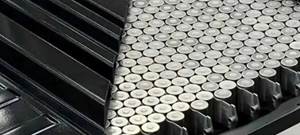MHI Vestas Offshore Wind receives breakthrough first order for the V164-8.0 MW
DONG Energy orders 32 of the joint venture's flagship wind turbine featuring 80m composite blades made in Isle of Wight, UK facility.
DONG Energy has placed the first commercial order for 32 of MHI Vestas Offshore Wind’s (Aarhus, Denmark) V164-8.0 MW- the world’s most powerful wind turbine- for the 258MW Burbo Bank Extension project off the coast of Liverpool Bay in the UK.
Blades for the project will be produced at the recently announced MHI Vestas Offshore Wind manufacturing facility on the Isle of Wight, off the southern coast of the UK- the first facility with the capacity to serial produce blades for future UK offshore projects.
Milestone project
CEO Jens Tommerup says the order marks a historic milestone for MHI Vestas Offshore Wind and the wind industry in the UK. “We are extremely pleased to receive the first commercial order for the V164-8.0 MW, our flagship wind turbine and a machine which will contribute to driving down the cost of offshore wind energy,” said Tommerup. “DONG Energy were closely involved in the development and testing of the turbine and today’s announcement represents a significant vote of confidence from the world’s leading developer of offshore wind in the V164-8.0 MW and MHI Vestas Offshore Wind.”
“MHI Vestas Offshore Wind will become the first manufacturer with the capacity to serial produce blades for future offshore wind projects in the UK. Serial production of 80m blades for the Burbo Bank Extension project will commence on the Isle of Wight from as early as Q2 2015.”
Samuel Leupold, Executive Vice President in DONG Energy, said “We are very excited to be able to construct the Burbo Bank Extension offshore wind farm. The introduction of the MHI Vestas Offshore Wind V164-8.0 MW turbine will be an important measure in our joint efforts to reduce the cost of electricity of offshore wind. Bigger turbines, producing electricity more efficiently is an important element in realising our ambitious targets.”
About the Burbo Bank project
The 258 MW Burbo Bank Extension project lies off the coast of Liverpool Bay, in the UK. When installed, the power plant will produce enough energy to meet the electricity requirements for approximately 180,000 houses.
The order includes supply, installation and commissioning of the wind turbines as well as a five year full-service contract. Installation is expected to begin in 2016, and commissioning is expected to be completed in 2017. Pre-assembly of the turbines will take place in Belfast, Northern Ireland.
Manufacturing in the UK
MHI Vestas Offshore Wind will utilize the production hall at Vestas’ blades technology center on the Isle of Wight beginning in January 2015 and will invest in upgrading the facility for serial production. The facility was opened in 2011 and was specifically designed to develop large blades for the latest wind turbines. The facility consists of two halls 170m long and 50m wide, one for testing and verification, and one for blade production, which will be leased by MHI Vestas Offshore Wind.
Tommerup commented, “The Isle of Wight is a world class R&D center for developing and testing blades. The blades for the V164-8.0 MW prototype were designed, manufactured and tested at the Isle of Wight facility so we have developed the unique skills and processes necessary to manufacture blades which makes it a good location to ramp up to serial production."
Related Content
Trends fueling the composites recycling movement
Various recycling methods are being considered for composites, from novel dismantling and processing, to building capacity and demonstrating secondary use applications.
Read MoreHigh-tension, vertical filament winding enables affordable flywheel energy storage system
French startup Energiestro’s prototype solar energy flywheel-based storage system aims to reduce costs with glass fiber composites and prestressed concrete.
Read MoreComposites end markets: Energy (2024)
Composites are used widely in oil/gas, wind and other renewable energy applications. Despite market challenges, growth potential and innovation for composites continue.
Read MoreComposites end markets: Batteries and fuel cells (2024)
As the number of battery and fuel cell electric vehicles (EVs) grows, so do the opportunities for composites in battery enclosures and components for fuel cells.
Read MoreRead Next
Scaling up, optimizing the flax fiber composite camper
Greenlander’s Sherpa RV cab, which is largely constructed from flax fiber/bio-epoxy sandwich panels, nears commercial production readiness and next-generation scale-up.
Read MoreNext-gen fan blades: Hybrid twin RTM, printed sensors, laser shock disassembly
MORPHO project demonstrates blade with 20% faster RTM cure cycle, uses AI-based monitoring for improved maintenance/life cycle management and proves laser shock disassembly for recycling.
Read MoreCeramic matrix composites: Faster, cheaper, higher temperature
New players proliferate, increasing CMC materials and manufacturing capacity, novel processes and automation to meet demand for higher part volumes and performance.
Read More











